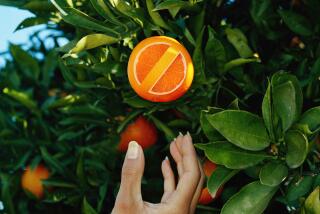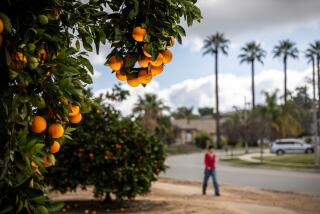Fruit Trees Need to Start Training Early
- Share via
The time to start training any fruit tree is just as soon as you put it in the ground.
Proper training is needed for strong limbs that will not break when they are eventually weighted down with fruit. Proper training also shapes the young tree to a form that keeps all the branches bathed in sunlight, even as the tree ages.
Train a fruit tree either to a “central-leader” shape or a “vase” shape. A central-leader tree looks like a Christmas tree, with a single trunk having successively longer scaffold limbs from top to bottom. Apple, pear and sweet cherry trees tend to naturally grow in this shape.
A vase-shaped tree has a short trunk, with three or four main scaffold limbs radiating upward and outward. Peaches, nectarines, apricots and most plum varieties naturally take on this form.
Let’s assume you have just planted your tree. If the tree is just a single, upright stem, cut that stem back to about 3 feet above ground level right after planting. The effect of this seemingly brutal act is to stimulate the growth of buds below the pruning cut.
On a central-leader tree, the topmost bud usually grows most vigorously and becomes a continuation of the main trunk. The lower buds give rise to less vigorous shoots, some of which will become major scaffold branches.
For a vase-shaped tree, three or four branches of about equal vigor become the major branches (with no continuation of the trunk).
As a tree grows in its first season, pick out which side branches to keep, then remove any others. But choose with care, because those you save will become the permanent framework.
Select the lowest side branch to originate a couple of feet above ground level. Any lower, and you will not be able to mow under the tree, and fruit will be on the ground while still attached to the branch. (The height of a branch does not change as a tree ages.)
To allow each side branch adequate light and room to develop, save those that are about 6 inches apart and arranged in a spiral fashion moving up and around the trunk. Branches you select should make a wide angle with the trunk, because such branches remain strongly attached even with age.
If your new tree already has side branches, shorten the best ones, then cut away any others right after planting.
That is the theory in training--but do not expect complete cooperation from a tree. A particularly well-placed branch may grow too weakly. Or a central-leader tree may try to make two main trunks instead of one. Or all the side branches may grow at sharp angles to the trunk.
In such cases, a bit of coaxing is needed. The cure for a well-placed but weak-growing branch is to cut it back severely, to a couple of buds. The buds will grow with renewed vigor.
To suppress growth of an overly rampant branch, such as one trying to overtake the central leader, pinch out its tip as it grows or bend the branch downward with a weight or with a string tied to the trunk.
Widen the angle on a narrow-angled branch by inserting a toothpick or clothespin between the branch and the trunk.
*
Training in subsequent seasons is a repeat of the first season, except higher up in the tree.
For a central-leader tree, treat the extension of the main trunk like a new whip. Cut it back by about a third to induce branching, then select new side branches. Cut back the laterals of a vase-shaped tree by about a third of their length to induce sublaterals.
For either shape of tree, cut away water sprouts, which are vigorous, upright shoots growing from the branches or the base of a tree.
The goals in training fruit trees are not only to build strong, well-shaped trees, but also to get fruit as soon as possible.
To this end, don’t get overenthusiastic about lopping off branches. Pruning can delay fruiting by stimulating lush but unfruitful growth.
Pruning a young tree is a necessary evil, but the less pruning the better.






